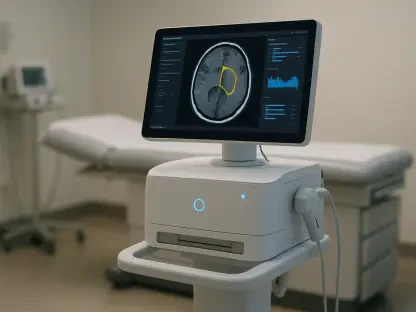In an era of rapid technological advancements, telehealth has emerged as a powerful force reshaping the healthcare landscape. This innovative approach, which harnesses digital communication tools to deliver medical care, is redefining how patients interact with healthcare providers, demonstrating its increasing relevance, offering both opportunities and challenges for the industry.
The Growth Trajectory of Telehealth
Rising Demand and Market Projections
The telehealth market’s expansion reflects a broader shift toward digital transformation in healthcare, with valuations set to rise significantly in the coming years. Valued at USD 22.8 billion in 2024, projections indicate that it could surge to USD 156.3 billion by 2035, driven by a compound annual growth rate (CAGR) of 19.15%. This remarkable growth trajectory underscores the increasing demand for accessible, affordable, and convenient medical services. Technological advancements, such as improved internet connectivity and the proliferation of smartphones, are pivotal in this evolution. At the same time, demographic changes, such as aging populations and the rising prevalence of chronic illnesses, further fuel this shift, underscoring the need for more adaptable healthcare solutions.
The demand for telehealth services was accentuated by the pandemic, which necessitated a reevaluation of traditional healthcare modalities. The COVID-19 crisis acted as a catalyst, accelerating virtual care adoption across the globe. It spurred healthcare systems to incorporate telehealth as a fundamental component of their service offerings, and the momentum has only continued in its aftermath. With its capacity to deliver timely, efficient care—particularly to individuals in rural or underserved areas—the telehealth model resonates with a changing patient and provider landscape.
Technological and Regulatory Drivers
Technological innovation continues to play a central role in propelling telehealth forward, with Artificial Intelligence (AI) and Machine Learning (ML) offering new dimensions to patient care. These technologies enable predictive analytics and virtual diagnostics, transforming routine medical inquiries into more efficient and precise processes. Beyond AI and ML, remote patient monitoring tools like wearable devices have become integral, allowing continuous health tracking outside traditional clinical environments. These technologies offer a more proactive approach to healthcare, improving patient outcomes and reducing costs.
Regulatory initiatives have also proven critical in sustaining telehealth’s growth. Governments around the world have implemented supporting policies and reimbursement models that facilitate virtual care’s integration into existing healthcare frameworks. Agencies in regions such as North America and Europe advocate for the permanence of these models, emphasizing long-term market stability. Efforts to streamline cross-border telehealth regulations are underway, promising to ease barriers for global expansion. Yet, discrepancies remain a challenge, necessitating coordinated efforts from stakeholders to build a cohesive regulatory environment. The focus on regulatory refinement and technological innovation, though crucial, also highlights areas of improvement that the industry must address.
Challenges and Opportunities in Telehealth
Technological and Infrastructure Barriers
Despite the promise of telehealth, several hurdles must be overcome to achieve its full potential. One of the most pressing issues is the disparities in technology access that can significantly impact the equitable adoption of telehealth services. Individuals in rural or low-income areas often face connectivity challenges and limited device availability, which can impede their ability to access virtual care. Furthermore, disparities in digital literacy, particularly among older patients, can hinder the effective use of telehealth platforms, necessitating additional support and education initiatives to bridge these gaps.
In addition to technological disparities, data security and patient privacy represent critical concerns within the telehealth landscape. These systems involve the digital exchange and storage of sensitive patient health information, making them vulnerable to cyber threats. Ensuring compliance with privacy regulations such as the Health Insurance Portability and Accountability Act (HIPAA) in the United States can be both technically complex and costly for healthcare providers. To fortify data protection, healthcare organizations must invest in robust cybersecurity measures and encryption technologies, albeit with the consideration of associated costs and resource demands.
Strategic Partnerships and Innovation
Even as challenges persist, telehealth presents opportunities for strategic growth and partnership. By collaborating with technology companies specializing in AI, IoT, and wearables, healthcare providers can expand their offerings and enhance the quality of care. These partnerships allow for the integration of sophisticated technologies into telehealth services, leading to more personalized and predictive healthcare solutions. Telehealth companies are also tapping into emerging markets, where increasing internet access and mobile device adoption present significant growth potential. These regions offer fertile ground for innovation and business development, paving the way for novel care delivery models.
Additionally, mental health care via telehealth remains a relatively untapped market with substantial opportunities. The rise in awareness and acceptance of mental health issues has prompted a greater demand for accessible mental health services. Teletherapy and digital mental health platforms can fill this gap effectively, reaching patients who might otherwise forgo treatment due to stigma or accessibility issues. The increasing focus on corporate wellness programs and telehealth-enabled insurance offerings also broadens the horizon for industry growth, highlighting new business avenues and customer segments ripe for engagement.
Future Considerations for Telehealth
Emerging Trends and Consumer Expectations
An interesting trend in telehealth is the incorporation of blockchain technology for secure, traceable, and efficient data management. By using decentralized ledgers, healthcare providers can ensure supplementary data protection and compliance with regulatory standards, thereby enhancing trust between patients and providers. Innovations in this area could lead to more secure telehealth systems that address prevalent data privacy concerns, aligning with consumer expectations for greater transparency and security.
Consumer behavior is another critical factor influencing the telehealth market, with patient expectations for comprehensive, seamless care technologies rising. The movement toward omnichannel healthcare delivery models, which integrate in-person, virtual, and hybrid care, is gaining momentum. This approach highlights the necessity of developing flexible systems capable of seamlessly transitioning across different modalities, offering patients consistent and high-quality healthcare experiences. As healthcare systems continue to advance, meeting consumer demands will be essential for maintaining engagement and satisfaction.
Policy and Industry Shifts
Long-term developments in telehealth will inevitably hinge on continued policy evolution and industry transformation. The alignment of global regulatory frameworks would enable more cross-border cooperation and service expansion, creating a more unified telehealth landscape. Stakeholders must advocate for policies that prioritize value-based care, facilitate technological innovation, and support scalable business models. These efforts will ensure that the telehealth sector can sustainably meet growing healthcare demands.
Industry players will need to remain vigilant of emerging technological innovations that promise to revolutionize healthcare delivery. By embracing new tools and methodologies, healthcare providers can offer enhanced patient experiences while driving operational efficiencies. The evolving healthcare ecosystem will encourage companies to remain agile and forward-thinking, positioning telehealth as a viable and indispensable component of modern medicine.
A New Era of Healthcare Delivery
In today’s world, where technological innovations are unfolding at an unprecedented pace, telehealth has emerged as a transformative player in the healthcare sector. This cutting-edge approach leverages digital communication tools, such as video calls, mobile apps, and online portals, to provide medical care, significantly altering the way patients connect with healthcare professionals. Telehealth enables patients to consult with doctors from the comfort of their own homes, reducing the need for physical visits, which can be time-consuming and costly. It has become a particularly crucial resource in remote areas, where access to healthcare facilities may be limited.
The continuous evolution of telehealth practices not only underscores their growing importance but also presents both opportunities and hurdles for the medical industry. On one hand, it offers the potential to streamline healthcare delivery, making it more efficient and accessible. On the other hand, it raises concerns about cybersecurity, patient data privacy, and the digital divide that may leave certain demographics behind. As telehealth becomes more integrated into mainstream healthcare, it is essential for policymakers, healthcare providers, and technology developers to work collaboratively to address these challenges and maximize the benefits of this promising innovation, ensuring it serves as a robust and reliable addition to traditional healthcare services.









